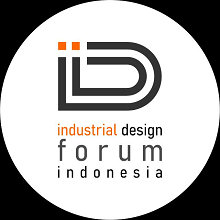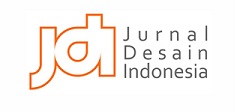TINJAUAN KONSEP DESAIN FLATPACK PADA RAK SUSUN 5 TINGKAT TERBUKA MASTERSPACE HOLELESS
Abstract
The success of developing new products is a prerequisite for companies to remain competitive in a market that is always demanding. The design concept with the term Flat-pack became very popular and inspired the design of other products, especially product design in small industries or artisans in Indonesia. Research on producing products that have successfully applied this design concept is very much needed to review and discuss the product details of the holeless level 5 Masterspace Rak as a product that will be a case study of how the design process and success in applying the Flat-pack design concept, with the basic principles of knockdown and RTA Ready theory To Assemble. The method that will be used to achieve the objectives of this research is the Basic Theory Method. In carrying out this method, it will be sought where phenomena can be said to be core phenomena that can be taken and formed into a theory. It is hoped that through this research, the results can be applied to the planning of craft innovative products by small craftsmen while still being able to compete globally.
Keywords
Full Text:
PDFReferences
Artikel desain, Buku
Baer, D. (2016). Inside the Ikea design process - Business Insider. December 9, 2018, Diambil dari: https://www.businessinsider.com/inside-the-ikea-design-process-2016-1/?IR=T
Chi-Wing Fu, & Peng Song (2017). Reconfigurable Interlocking Furniture. Diambil dari: http://www.cse.cuhk.edu.hk/~cwfu/papers/reconfig/index.htm
Corbin, J., & Strauss, A. (2008). Basics of qualitative research: Techniques and procedures for developing grounded theory. California: SAGE Publiation.
Dahlborg, H., & Johnsson, C. (2006). Evaluating Packaging Logistics Development at IKEA for Improvements in Product and Packaging Development. Thesis: Lund University.
Fan, J. N., & Schodek, D. (2007). Personalized furniture within the condition of mass production. In The 9th international conference on ubiquitous computing (Ubicomp ‘07). Austria: Innsbruck.
Harris, R. Wen Shao Chang. Walker, P (2014). Engineering Research into Traditional Timber Joints. Diambil dari: https://researchportal.bath.ac.uk/en/publications/engineering-research-into-traditional-timber-joints
Hughes, P. (1996, January). Exporting furniture: Getting the packaging right. In. International Trade Forum, 1, 8. International Trade Centre.
Holman, W. (n.d.). Guerilla Furniture Design: How to Build Lean, Modern Furniture with Salvaged - Will Holman - Google Book. Diambil dari: https://books.google.co.id/books?id=1F3BBwAAQBAJ&printsec=frontcover&hl=id#v=onepage&q&f=false
Ikea. (2018). About/Democratic Design. December 9, 2018. Diambil dari: https://www.ikea.co.id/in/tentang/democratic-design/
Kong, S. C., Ogata, H., Arnseth, H. C., Chan, C. K. K., Hirashima, T., Klett, F., & Mitrovic, A. (2009). Constraint-based design critic for Flat-pack furniture design. In Proc. of the 17th International Conference on Computers in Education (pp. 19-26).
Moon, Y. (2004). IKEA invades America. Harvard Business School: USA.
Turner, troy. (2012). Flat-pack Elegance | Yanko Design. December 16, 2018, Diambil dari: https://www.yankodesign.com/2012/05/21/Flat-pack-elegance/
What is Flat-pack Furniture? Flat-pack Mates Explain it All! (2018). December 16, 2018, Diambil dari:
https://Flat-packmates.co.uk/blog/Flat-pack-furniture-explained/
Jurnal
Ainsworth, S., & VanLabeke, N. (2004). Multiple forms of dynamic representation. Learning and instruction, Volume 14(3), 241-255.
Burdurlu, E., Ciritcioglu, H. H., Bakir, K., & Ozdemir, M. (2006). Analysis of the most suitable fitting type for the assembly of knockdown panel furniture. Forest products journal, Volume 56(1), 46-53.
Chi-Wing Fu, & Peng Song. (2015). Computational Interlocking, Furniture Assembly, Volume 34(4), Article 91. Diperoleh dari link: http://cs.tau.ac.il
Egan, T. Marshall. (2002). Grounded Theory Research and Theory Building. Advances in Developing Human Resources, Volume 4(3).
Li, H., Guo, H., Skibniewski, M. J., & Skitmore, M. (2008). Using the IKEA model and virtual prototyping technology to improve construction process management. Construction Management and Economics. Construction Management and Economics, Volume 26(9):991-1000.
Löfgren, O. Design and Culture. Design by IKEA. A Cultural History. (2015). The Journal of the Design Studies Forum, Volume 7(3), 467-471. DOI: https://doi.org/10.1080/17547075.2015.1105510
Martin, Patricia Yancey and Barry A. Turner (1986). Grounded Theory and Organizational Research. The Journal of Applied Behavioral Science, Volume 22 (2).
Panghegar, A. F., & Pratama, D. (2017). Aplikasi Desain Flat-pack sebagai Upaya Efisiensi Produksi dan Logistik Studi Kasus: Bangku Bongkar Pasang KURIKKU. Simposium Nasional RAPI XVI – 2017 FT UMS, 39-47.
Puspita, A. A. P. A., Sachari, A., & Sriwarno, A. B. (2016). Dinamika Budaya Material pada Desain Furnitur Kayu di Indonesia. Panggung, Volume 26(3).
Ramadhan, A., & Sihombing, J. P. (2017). Kajian ergonomi desain sepeda fixed gear (fixie). PRODUCTUM Jurnal Desain Produk (Pengetahuan dan Perancangan Produk), Volume 3(1), 8-21.
Simek, M., & Sebera, V. (2010, October). Traditional furniture joinery from the point of view of advanced technologies. In Proceedings of the international convention of society of wood science and technology and United Nations economic commission for Europe—Timber Committee, Geneva, Switzerland (pp. 11-14).
DOI: http://dx.doi.org/10.22441/narada.2020.v7.i2.008
Refbacks
- There are currently no refbacks.
Fakultas Desain dan Seni Kreatif
Universitas Mercu Buana
Gedung E Lantai 4
Jl. Raya Meruya Selatan no.1, Kembangan, Jakarta 11650
Tlp./Fax: +62215871335
Journal International Standard Serial Number (ISSN) Registration:
The Journal is indexed by:
Tools for Citations & Plagiarism Detection:

Ciptaan disebarluaskan di bawah Lisensi Creative Commons Atribusi-NonKomersial 4.0 Internasional
 NARADA: Jurnal Desain dan Seni
NARADA: Jurnal Desain dan Seni

























